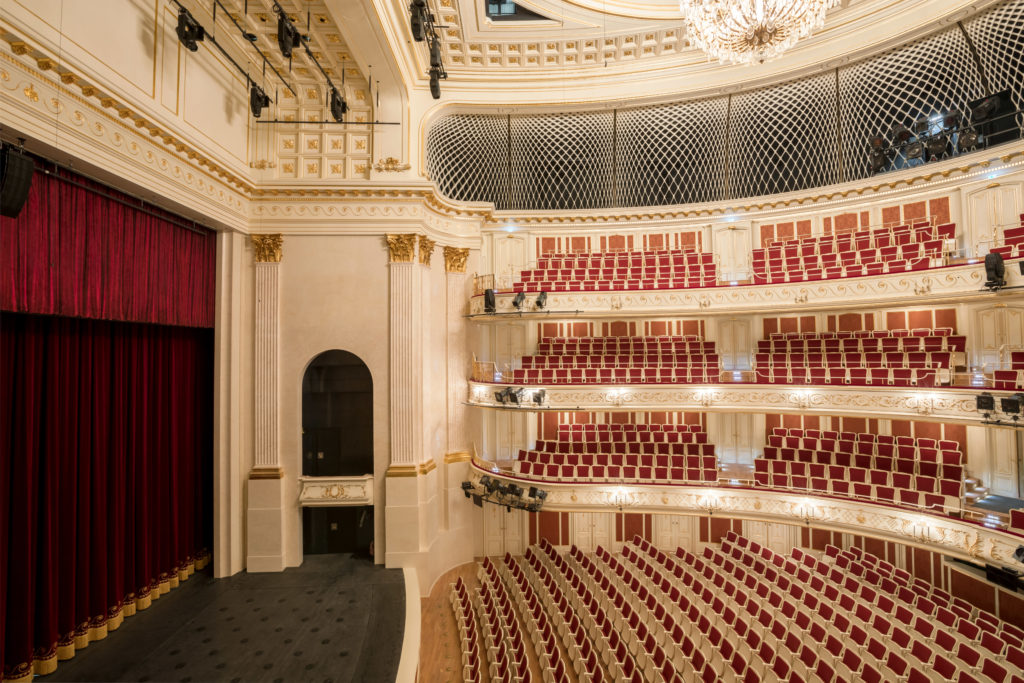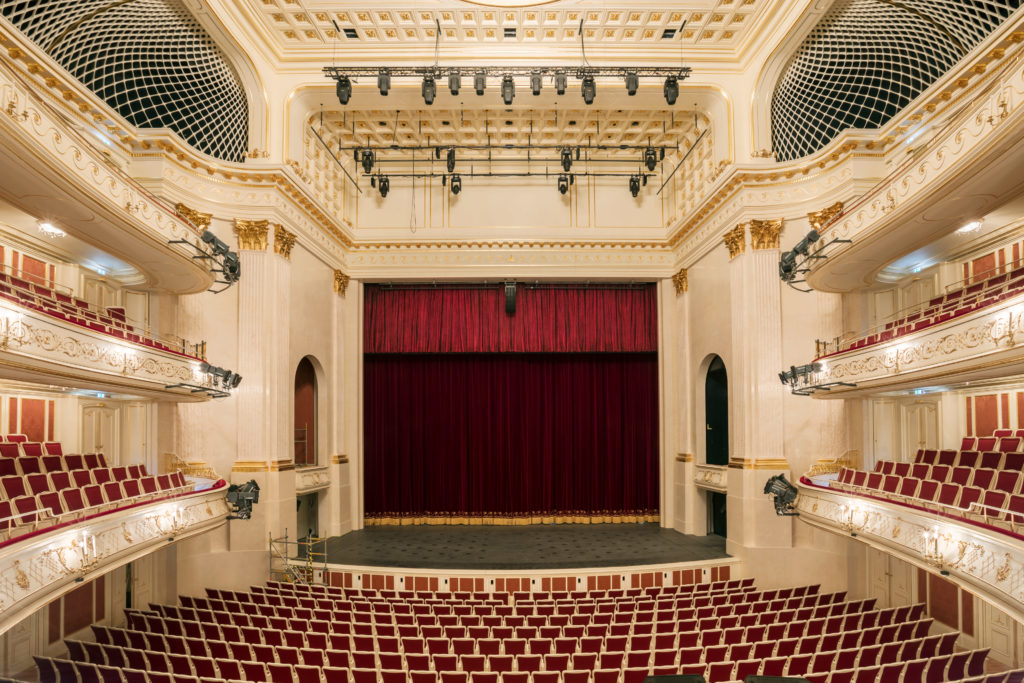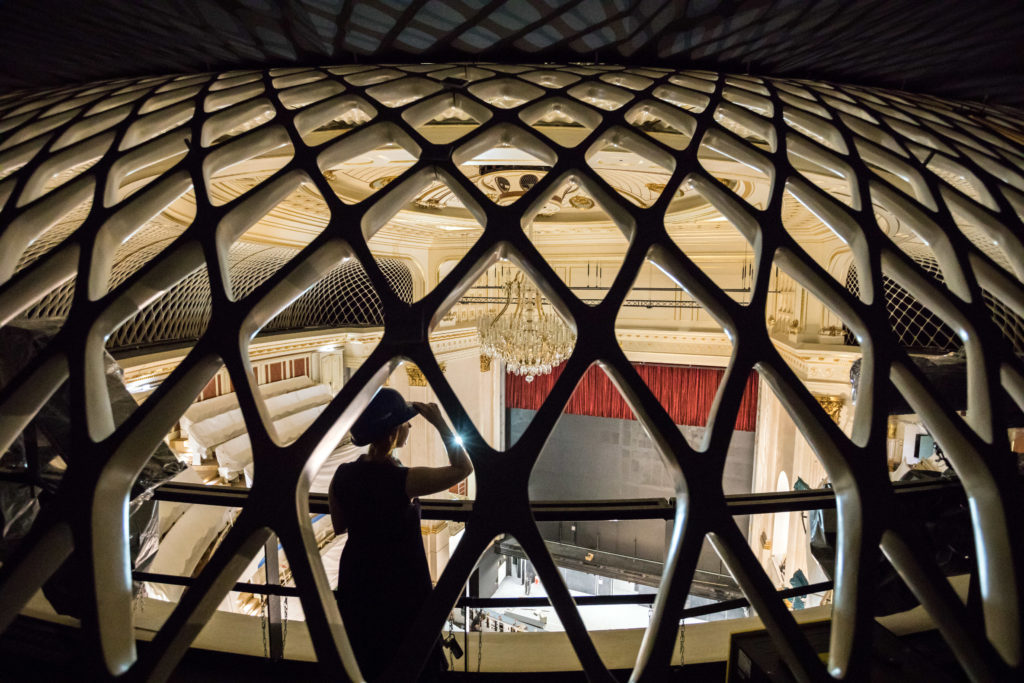Pretty in Pink. The Renovated Staatsoper in Berlin
After eight years of renovation, the German State Opera House, or Staatsoper, on Unter den Linden, has reopened its doors, under the musical direction of Daniel Barenboim. Not only did the renovations take a long time but they were expensive. Almost a half billion Euros were invested into four buildings. But the results are stunning, and for those of us interested in memory, place, and reconstruction in the German capital, the building makes for lively discussion.

The near decade of building works corresponds to the time I’ve spent living in the city. Only during my first year in Berlin was I able to go to performances at the Staatsoper (I remember a fabulous Così Fan Tutte set in 60s Naples with vespas and period fashions). This autumn, revisiting a space I hadn’t seen for nearly a decade brought me back to feelings and thoughts from my first, impressionable, time in Berlin.
Built as the Königliche Hofoper (Royal Court Opera), commissioned by Frederick the Great (1712-1786) as part of a larger eponymous building project, the Forum Fridericianum on Bebelplatz, it was the first opera house built independently of a palace north of the Alps. The architect was Hans Georg von Knobelsdorff (1699-1753), working in a Palladian Classical style.

One of the first reactions when seeing the 2017 renovation is: it’s so pink! This was very noticeable when we attended the Beethoven 9th symphony open-air “Staatsoper für Alle” concert in late September to celebrate the opening. The sun was setting on the building on the Bebelplatz side, and old ladies sitting on their portable camp chairs around me pointed, remarking on the hue. Not powder pink, more like stained pink. It’s a pink that was applied during the 1952–1955 renovation under the direction of Richard Paulick, an architect who worked in a Communist-sanctioned National Style (the Staatsoper having been bombed twice during the Second World War). It’s a colour that is associated with the Communist years, and for some it must be incomprehensible why after such an expensive reconstruction this pink facade should somehow reappear.

This colour tells us a few things though about the reconstruction. The first is that the architects are at pains, especially in their press material, to impress that the “aim of the renovation was to restore the Staatsoper to its original State under Frederick II, as interpreted by Richard Paulick’s post-war reconstruction”. I’m sure I’m not the first to recognise a contradiction in this sentence. How can you restore to the “original state” and also do it as interpreted by the GDR period? Well, this is only achievable if the building was the same in both eras, and––funnily enough–– in the case of our pink colour, it turns out, they were. It is likely that the original colour on the façade on the building in 1743 was a similar pink to the one that Paulick used in the 1950s. After a fire, in 1843, the building was (sensibly?) painted a different colour (which one, does anyone know?), which it remained for a century, and the pink became associated with the post-war Communist renovation. I’m not sure how I feel about the pink, to be honest.

But let’s get back to why this new Staatsoper goes to such an effort to recognise the Communist-era renovation. I think the answer to this question has to do with the other great building project you can see––through the windows of the Staatsoper’s elegant reception area, the Apollosaal––down Unter den Linden.
The Berlin State Palace (Berliner Schloss) project is a rebuilding of a palace that disappeared when the East Germans detonated it in 1950. The new building has modern additions, but from this angle appears simply a reconstruction of the Baroque Palace. It’s arguably an abridgement from today to the period before the East German capital building, the Palast der Republik, occupied this space. The Schloss has been roundly criticised for erasing the Communist past, and I suspect that the architects of the Staatsoper were concerned that the criticism might be launched their direction as well.

Paulick’s renovations were celebrated at the time. That said, I remember the interior, pre-2017 renovation, as heavy, claustrophobic, with touches of false pompous elegance with faded materials. Returning, one feels in place that it is still crowded: the tight downstairs receptions spaces were designed by Paulick, and the chandeliers in the hallways and Konditorei are a little too heavy for the low ceilings. But the difference is that one senses that the cake was baked this time with excellent ingredients and a lot of the kitsch of the national style has been pared down. Certain details––such as the statues of Greek dramatists on the north balcony––have been beautifully restored. What one senses more than anything is that a lot of money has been spent. The budget is visible, it’s not a place where you ask “where did the money go?” We now occupy a building that sparkles with elegance and luxury, instead of one that––I think perhaps in a salutary way––reminded us that we were in a space that was a shadow of itself, rebuild in an era for the people.

Because I must say that I felt something on this visit to the Staatsoper that I had never felt before in my previous visits, and which is hard to qualify, let alone quantify. There was a kind of mannered froideur, even snobbism, from occupying a place that is so elegant. The Staatsoper has been completely de-socialised now. It is again the luxurious space it was built to be, while before the “false” elegance of the GDR always reminded you that you were in a simulacrum of a bourgeois past. Its visitors knew better than to embrace the gilt. This kept it a people’s place, rather than one for the haute bourgeoisie. The Communists in 1949 emblazoned the façade with the words, in German, “Deutsche Staatsoper”, but now the original Latin, “Fridericus Rex Apollini et. Musis” (King Frederick dedicates this building to Apollo and the Muses) has been restored. With it, we recall an aristocracy, which was of course abolished. That recalling of aristocratic privilege is something also seen in the Berlin City Palace just down the street.

Much of the money spent has been on details that are not purely decorative. hg merz architects (who work between Stuttgart and Berlin) oversaw the renovation, which included a huge project to lift the roof of the performance hall by 4,5 m. This was done to improve the acoustics, by adding a reverberation gallery––which looks like a rococo diamond lattice that sweeps around the edge of the vault––which increases reverberation time in the hall from 1.1 to 1.6 seconds. It’s a conspicuous, but elegant, feature in the main hall that I think brilliantly melds form with function. Much of the interior, including the lattice, is a glistening polished white, that gives a lightness to the space that was absent in the GDR building. Another necessary repair was to protect the building from groundwater (oak trees, were, interestingly enough, the solution to this problem––they firmed up the ground–– when the original 18th-century structure was built). Meanwhile, now the actors don’t need to freeze their asses off by stepping outside between the rehearsal spaces and the hall: there’s a new underground gallery.

Photo used with permission.
Setting foot back into the building, for the first time after nearly a decade, I saw a good performance of Monteverdi’s Incoronation of Poppea. I think Poppea was a good choice, because this Monteverdi’s opera was one that was first performed in 1643, then in Naples in 1651, but remained unplayed for many centuries until its rediscovery in 1888. Berlin was important to the rediscovery of Monteverdi, as Orfeo was resurrected here in this building in 1881. I like listening to Monteverdi in a building that is also about rediscovery, reinvention.

In the entr’acte we wander into the opulent Apollosaal where the Royal court also held balls. It is a bright space with enormous chandeliers. A very stale Bretzel and a bottle of beer keep one’s feet on the ground, as we turn to the enormous windows looking out on to Unter den Linden. In one direction, you look up the avenue to the Brandenburg Gate. Down the other way, you see the Berlin City Palace rising.
We have spent so much time talking about the view towards the building. But looking from the building out to the street gives another historic impression. Through the wooden frames of the window, the view is restricted. With the night, and the dampened streets reflecting the lanterns of vehicles, things are blurry enough that one can imagine oneself in a more distant past––perhaps as early as the 1920s, before the bombing. There are in fact few places in Berlin where one can imagine oneself in such a past, where the details outside––and in the interior space behind––do not interrupt the illusion of an older Europe.
The sense of connectedness, that this view provides, is not about indulging in nostalgia, but rather it awakens an imagination for the past. We can imagine ourselves living at different moments of time in this city. We can imagine how many other people stood here with the same view and thought about who else might have stood in their place. A window of the Deutsche Staatsoper at night is one of the few places in the city where we can enter easily into this contemplation as there are so few traces of the 21st century visible. It’s the kind of guilt pleasure that, occasionally, can be also very satisfying.
